This article provides details for new and existing users who need to configure a fresh install of the IDE or upgrade the versions of Red Hat JBoss Enterprise Application Platform or JBoss Web Framework Kit in use.
The IDE supports application development and deployment with JBoss EAP and JBoss Web Framework Kit only after you configure the IDE for use with JBoss EAP and JBoss Web Framework Kit. This configuration is essential for using the enterprise versions of the example Maven projects provided in JBoss Central. These projects are intended for deployment to JBoss EAP and necessitate IDE access to the JBoss EAP and JBoss Web Framework Kit Maven repositories.
Instructions are provided for the following tasks:
-
Set up JBoss EAP for use in the IDE in one of three different ways
-
Configure Maven for JBoss EAP and JBoss Web Framework Kit Maven repositories
1. Set Up JBoss EAP
To set up JBoss EAP for use in the IDE, you must direct the IDE to the local or remote runtime servers. This establishes a communication channel between the IDE and the JBoss EAP server for efficient deployment and server management workflows. Depending on your circumstance, you can set up the JBoss EAP server in one of three ways:
-
If you are installing a new instance of the IDE, you can use Red Hat Development Suite to download, install, and set up the IDE and JBoss EAP.
-
If you already have the IDE installed but not JBoss EAP, you can download, install, and set up JBoss EAP from within the IDE.
-
If the IDE and JBoss EAP are already installed, you can use runtime detection to set up JBoss EAP from within the IDE.
A Downloading, Installing, and Setting Up the IDE and JBoss EAP using the DevSuite Installer
If you are installing a new instance of the IDE, you can use the Red Hat Development Suite Installer to download, install, and set up the IDE and JBoss EAP. A specific JBoss EAP version is packaged in the installer. For details of the components installed through Red Hat Development Suite, see Component Details in the Red Hat Development Suite Installation Guide.
|
If you want to install a different version of JBoss EAP, you can either download it from within the IDE (see download, install, and set up JBoss EAP from within the IDE)) or install it separately and then follow the instructions in C, use runtime detection to set up JBoss EAP from within the IDE. |
For detailed instructions on installing Red Hat Development Suite, see the Red Hat Development Suite Installation Guide.
To download, install and set up the IDE and JBoss EAP using the DevSuite Installer:
-
Log in and download Red Hat Development Suite from the Red Hat Developers Portal product download page at Red Hat Developers Download. Note that you must unzip macOS installers before the next step. If using the Safari browser to download, the macOS installer is automatically unzipped.
-
Run the downloaded installation file (Online or Bundled).
-
In the Red Hat Development Suite window, click Next to continue.
-
In the Target Folder window, in the Select the installation folder field, type the location where you wish to install Red Hat Development Suite and then click Next to continue. The Confirmation window lists the components that are available for download and installation through Red Hat Development Suite.
This use case requires you to only download JBoss Developer Studio and Red Hat JBoss Enterprise Application Platform. However, you may choose to download any additional or all the components available through Red Hat Development Suite.
-
Click the Red Hat JBoss Developer Studio and Red Hat JBoss Enterprise Application Platform checkboxes and click Next.
-
In the Account window, enter your existing Red Hat Developer login credentials.
-
Click Download & Install to continue. The Download & Install window shows the progress of the installation.
-
In the Get Started window, click Open Red Hat JBoss Developer Studio.
-
In the Eclipse Launcher window, select the workspace location where you want to store the project data and click Launch.
-
The Searching for runtimes window, automatically searches and detects the available runtimes.
-
From the table, click Red Hat JBoss EAP 7.0 and click OK.
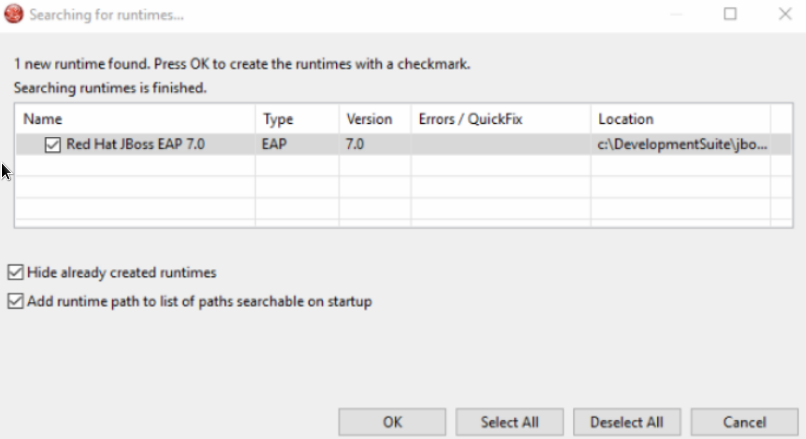 Figure 1. Searching for runtimes Window Listing Red Hat JBoss EAP 7.0
Figure 1. Searching for runtimes Window Listing Red Hat JBoss EAP 7.0Result: Open the Servers view, to see the Red Hat JBoss EAP 7.0 server listed in the Stopped mode.
B. Download, Install and Set Up JBoss EAP from within the IDE
If the IDE is already installed, you can download, install, and set up JBoss EAP from within the IDE. With this option, you can choose from a range of supported JBoss EAP versions; for details of supported JBoss EAP versions see https://access.redhat.com/site/articles/427493.
To download, install and set up JBoss EAP from within the IDE:
-
Start the IDE.
-
Click Window > Preferences, expand JBoss Tools, and then click JBoss Runtime Detection.
-
In the Paths pane, click Download.
-
In the Download Runtimes window, from the Download Runtimes table select the JBoss EAP version that you want to download and click Next.
For JBoss EAP 6.1.x and later, continue to follow the steps given here. For JBoss EAP 6.0.x and earlier, follow the on-screen instructions for downloading JBoss EAP from the Red Hat Customer Portal and after JBoss EAP is installed continue to use runtime detection to set up JBoss EAP from within the IDE.
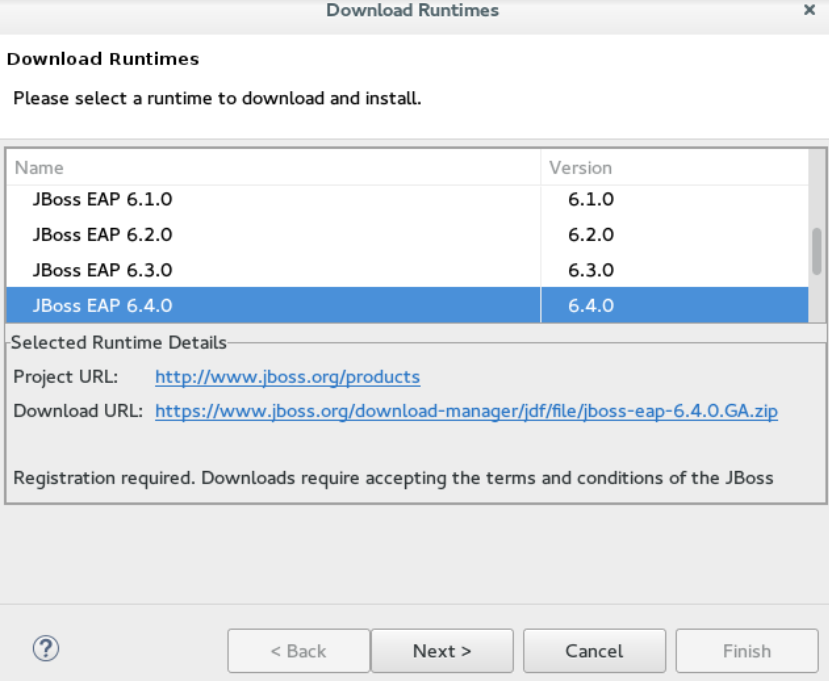 Figure 2. Download Runtimes Window Listing Available JBoss EAP Versions
Figure 2. Download Runtimes Window Listing Available JBoss EAP Versions -
In the JBoss.org Credentials window, in the Domain field, type jboss.org and then click Add next to the Username field. Note that if you do not have a JBoss.org account, you must click the link to sign up.
-
In the Add a Credential window, Username field, type your username and in the Password field, type the password and click OK.
-
In the Download Runtimes window, click Next.
-
In the JBoss.org Terms and Conditions window, read the terms and conditions, from the Please choose the country of use list, select your country of use, and then click Accept Now. If you have previously accepted the terms and conditions in the IDE or through the jboss.org website, this window is skipped.
-
Click Next.
-
Read the General Public License, click I accept the terms of the license agreement, and then click Next.
-
For the Install Folder field, click Browse and choose a location in which to install JBoss EAP and click Finish.
-
Click Apply and click OK to close the Preferences window. The download and installation starts and may take some time to complete.
Result: The server is listed in the Servers view in Stopped mode.
C. Use Runtime Detection to Set Up JBoss EAP from within the IDE
If the IDE and JBoss EAP are already installed, you can use runtime detection to set up JBoss EAP from within the IDE. The runtime detection feature automatically identifies the JBoss EAP instance installed on your local system and generates a corresponding default server setup for use in the IDE. This feature makes getting started with a default JBoss EAP server very quick.
|
Specific JBoss EAP versions are supported by each IDE release; for details of supported JBoss EAP versions see |
To use runtime detection to set up JBoss EAP for use in the IDE:
-
Start the IDE.
-
Click Window > Preferences, expand JBoss Tools, and then select JBoss Runtime Detection.
-
Click Add.
-
Navigate to
path/to/jboss-eapand click OK. JBoss Server Tools recursively scans the path searching for installed servers and displays a list of those it finds. -
Ensure the jboss-eap-version check box is selected, where version denotes the JBoss EAP version, and click OK.
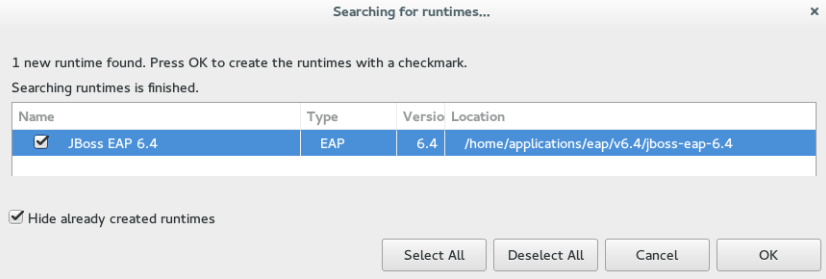 Figure 3. Selecting a Runtime
Figure 3. Selecting a Runtime -
Click Apply and click OK to close the Preferences window.
Result: The server is listed in the Servers view in the Stopped mode.
2. Configure Maven for JBoss EAP and JBoss Web Framework Kit Maven Repositories
To configure Maven to use the JBoss EAP and JBoss Web Framework Kit Maven repositories when working inside the IDE, you must ensure that the IDE knows the location of your Maven configuration settings.xml file and that the necessary profiles for the JBoss EAP and JBoss Web Framework Kit Maven repositories are contained in that file. This ensures that Maven knows where to search for project dependencies when it is called to build Maven projects from within the IDE.
Specify Maven settings.xml File Location
If you have multiple Maven settings.xml files or you are using a shared settings.xml file, then this file may not be in the default location expected by the IDE. In this case, you must inform the IDE of the file location.
To specify the Maven settings.xml file location:
-
Start the IDE.
-
Click Window > Preferences, expand Maven, and then click User Settings.
-
For the User Settings field, click Browse and locate the
settings.xmlfile. -
Click Update Settings.
-
Click Apply and then click OK.
Use JBoss EAP and JBoss Web Framework Kit Maven Repositories
You can either download the JBoss EAP and JBoss Web Framework Kit Maven repositories from the Red Hat Customer Portal or use the online Maven repository located at https://maven.repository.redhat.com/ga.
Use the Offline Maven Repositories
If you have not previously used these versions of JBoss EAP and JBoss Web Framework Kit, you must configure your Maven settings.xml file to use the associated product Maven repositories. You can manually edit your settings.xml file in a text editor or use the JBoss Developer Studio Maven integration feature to automatically detect the JBoss repositories and appropriately edit your settings.xml file.
|
The JBoss EAP and JBoss Web Framework Kit Maven repositories must be already obtained from the Red Hat Customer Portal and located on a system that you can access. |
To specify the JBoss EAP and JBoss Web Framework Kit Maven repositories locations using the IDE:
-
Start the IDE.
-
Click Window > Preferences, expand JBoss Tools, and then click JBoss Maven Integration.
-
Click Configure Maven Repositories.
-
Click Add Repository.
-
Click Recognize JBoss Maven Enterprise Repositories.
-
Navigate to
path/to/jboss-eap-maven-repositoryand click OK. JBoss Maven Tools recursively scans the path searching for a Maven repository. -
Modify the information in the ID and Name fields as desired, ensure the Active by default check box is selected, and then click OK.
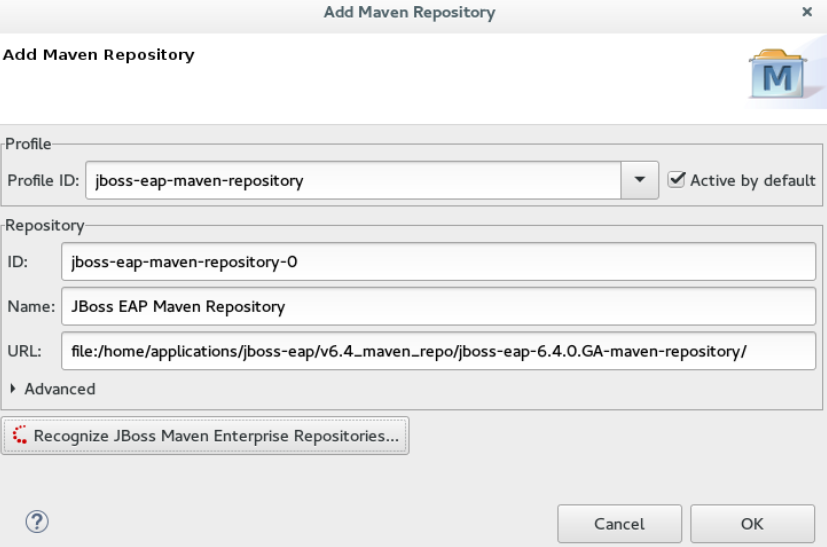 Figure 4. Details of the Selected Maven Repository
Figure 4. Details of the Selected Maven Repository -
Click Add Repository.
-
Click Recognize JBoss Maven Enterprise Repositories.
-
Navigate to
path/to/jboss-wfk-maven-repositoryand click OK. JBoss Maven Tools recursively scans the path searching for a Maven repository. -
Modify the information in the ID and Name fields as desired, ensure the Active by default check box is selected, and then click OK.
-
Click Finish and at the prompt asking if you are sure you want to update the Maven configuration file click Yes. If the specified configuration file does not exist, JBoss Maven Tools creates it.
-
Click Apply and click OK to close the Preferences window.
Use the Online Maven Repositories
Adding the online repository to the IDE, adds https://maven.repository.redhat.com/ga to your settings.xml , which takes care of all the dependencies.
To use the online Maven repositories:
-
Start the IDE.
-
Click Window > Preferences, expand JBoss Tools, and then click JBoss Maven Integration.
-
Click Configure Maven Repositories.
-
Click Add Repository.
-
In the Profile ID drop-down list, select redhat-ga-repository.
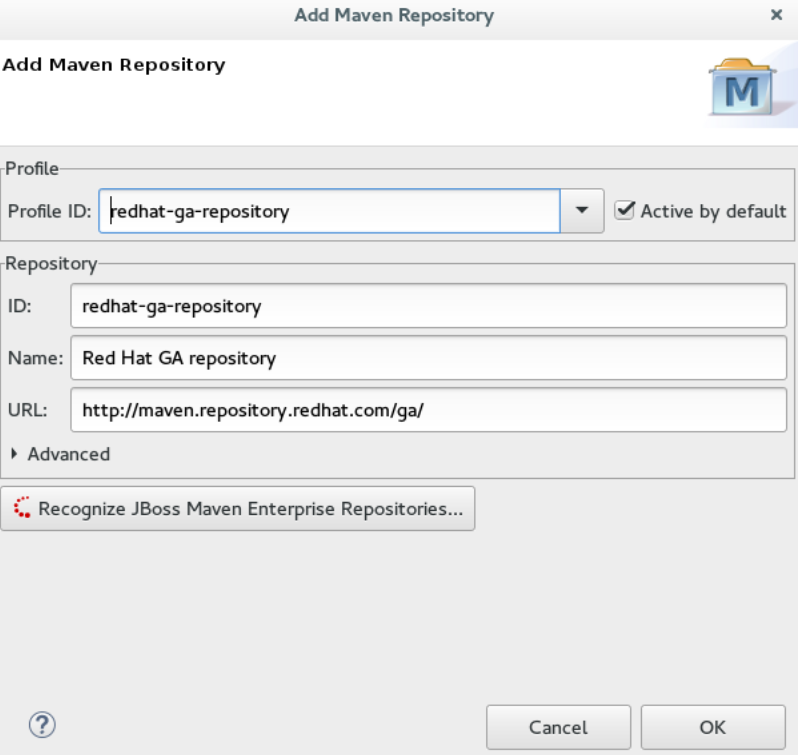 Figure 5. Add a Maven Repository
Figure 5. Add a Maven Repository -
Click OK.
-
In the Configure Maven Repositories window, click Finish.
-
Click Apply and then click OK to close the Preferences window.